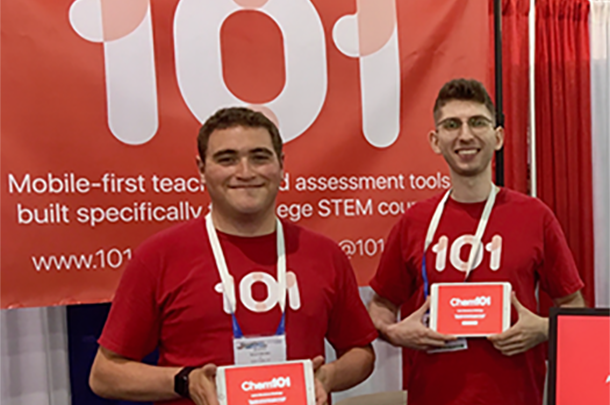Student startup will change the STEM lecture forever
Chemical engineering Ph.D. student Justin Weinberg is hoping to turn teaching on its head with his startup, 101.
The lecture has been the prevailing method of teaching on college campuses since the Middle Ages. Since then, we’ve gone from horse and carriage to the self-driving car, the printing press to the internet, and the abacus to the smartphone. Yet, the university lecture remains essentially unchanged, especially for the millions of students who enroll in challenging math and science courses every year. But chemical engineering Ph.D. student Justin Weinberg is hoping to turn teaching on its head with his startup, 101.
Today, only 40% of college students who declare a STEM major complete their degree, prompting the U.S. government to request a 33% increase in annual STEM graduates for the newly changing workforce. It’s clear that something must be done to retain and encourage more of these students to complete their degrees. According to Weinberg, the key to doing that is helping professors engage their students in the classroom with active learning.
“What we’re trying to do with 101 is take college STEM out of the dark ages of passive learning, and usher in the new age of active learning,” he says, “We’re doing this by inventing tools that allow professors to easily integrate problem-solving exercises into the lecture that students can solve right on their personal devices.” In fact, at least 62 published research studies have confirmed that incorporating active learning into the lecture decreases the failure rate in college STEM courses.
What we’re trying to do with 101 is take college STEM out of the dark ages of passive learning, and usher in the new age of active learning.
Justin Weinberg, Chemical Engineering Ph.D. student, Carnegie Mellon University
Weinberg and his co-founder, Igor Belyayev, first became aware of this problem years ago while studying together at Cooper Union, when they created a mobile app called Chem Pro, which features video lessons that help students learn chemistry. When it got over 500,000 downloads from students all across the country without any advertising, they realized the need for a change in the way chemistry is taught, and the tools used to teach it.
The team recently introduced their first classroom engagement product for chemistry students called Chem101. The debut module of the app focuses on the teaching of Lewis structures—the specific notation used to draw molecular structures—which is a core part of early chemistry education. Using Chem101, professors can assign a Lewis structure problem mid-lecture by sending it directly to students’ mobile devices over the cloud. Students respond to the question using an intuitive drawing tool to build out the structure, then send their answer back to the professor. This way, instructors can actually observe and address student mistakes in real-time, before they start failing exams or dropping the course.
“This is the first subject-specific response tool, which makes it very attractive to professors,” says Weinberg. “Clickers and other digital response tools only allow students to answer generic questions like multiple choice. Chem101 actually helps students learn the subject matter because they can visualize concepts like molecular geometry and obtain feedback on their answers that they would otherwise never get.”

Source: Carnegie Mellon University College of Engineering
Co-founders Justin Weinberg and Igor Belyayev debut Chem101 at the American Chemical Society (ACS) National Meeting in August 2016
Weinberg and Belyayev just finished piloting Chem101 with 2000 students in nine schools, ranging from elite universities, to community colleges, to high school AP courses. So far, of the students using the module, 77% said they preferred it to other existing courseware like clickers and e-books, and 40% of students said Chem101 made them more interested in chemistry after using the product for just 2-3 weeks of the curriculum. In one case study, they measured up to a 200% improvement in learning gains for students who used Chem101 versus students who didn’t (based on common pre and post-semester exams).
“When I went out and visited the campuses during our pilots, you could tell something really special was going on. As soon as a professor would send out a question, heads went down and students started discussing the problems with each other. Everyone was totally engaged,” he said. “We’re now expanding our development team and raising an investment round so we can add more curriculum support to Chem101. From there, we want to explore opportunities to break into more STEM subjects like math, physics, and biology.”
The team has already received invaluable support from the Carnegie Mellon community through the Swartz Center for Entrepreneurship and Project Olympus, as well as numerous faculty members. External supporters and investors include Dreamit, Rough Draft Ventures, and Dorm Room Fund. And with future support, 101 will continue to bring college STEM courses into the 21st century.
